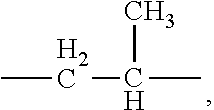Sterilized compositions of cyanoacrylate monomers and naphthoquinone 2,3-oxides
- Summary
- Abstract
- Description
- Claims
- Application Information
AI Technical Summary
Benefits of technology
Problems solved by technology
Method used
Image
Examples
example 1
[0086]In a three neck round bottom flask equipped with a magnetic stir bar, 5.2 g of vitamin K1 oxide was mixed with 98.8 g of the activated 2-octyl cyanoacrylate that includes 0.719 g of butylated hydroxyanisole, 0.468 g of SO2 solution (0.579%), 6 mg of DC violet #2, and 20.8 mg of 18-crown-6 at room temperature. Vitamin K1 oxide was well-miscible with 2-octyl cyanoacrylate. The viscosity and set time of the composition were 7.65 cps and 27.5 seconds, respectively.
example 2
[0087]114.7 g of the activated 2-octyl cyanoacrylate with 0.654 g of butylated hydroxyanisole, 2.1 mg of SO2, and 0.9 mg of DC violet #2 was mixed with 0.574 g of vitamin K1 oxide in a three neck round bottom flask equipped with a magnetic stir bar, to which 23 mg of 18-crown-6 was added. Vitamin K1 oxide is miscible with 2-octyl cyanoacrylate composition right away. The composition was sterilized by Gamma irradiation at the dose range of 9.4-11.0 kGy. Upon sterilization, the increase in viscosity of the composition is 1.06 cps. The average set time of the composition after sterilization was 27.5 seconds.
example 3
[0088]In a three neck round bottom flask equipped with a magnetic stir bar, 0.7 g of 2-methyl-1,4-naphthoquinone was mixed with 232.6 g of the activated 2-octyl cyanoacrylate that includes 1.676 g of butylated hydroxyanisole, 6 mg of SO2, 20.4 mg of DC violet #2, and 46.7 mg of 18-crown-6 at room temperature. 2-methyl-1,4-naphthoquinone was well-miscible with 2-octyl cyanoacrylate. The composition was sterilized by Gamma irradiation at the dose range of 9.8-11.3 kGy. After the sterilization, the composition was evaluated using an advanced aging protocol (American Society for Testing and Materials (ASTM) accelerated aging standard F1980-07), by storing the composition at 80° C. for 13 days. At day 13 of the accelerated aging study, the viscosity and set time of the composition were 20.2 cps and 32.5 seconds, respectively.
PUM
| Property | Measurement | Unit |
|---|---|---|
| Fraction | aaaaa | aaaaa |
| Fraction | aaaaa | aaaaa |
| Fraction | aaaaa | aaaaa |
Abstract
Description
Claims
Application Information
 Login to View More
Login to View More - R&D
- Intellectual Property
- Life Sciences
- Materials
- Tech Scout
- Unparalleled Data Quality
- Higher Quality Content
- 60% Fewer Hallucinations
Browse by: Latest US Patents, China's latest patents, Technical Efficacy Thesaurus, Application Domain, Technology Topic, Popular Technical Reports.
© 2025 PatSnap. All rights reserved.Legal|Privacy policy|Modern Slavery Act Transparency Statement|Sitemap|About US| Contact US: help@patsnap.com



